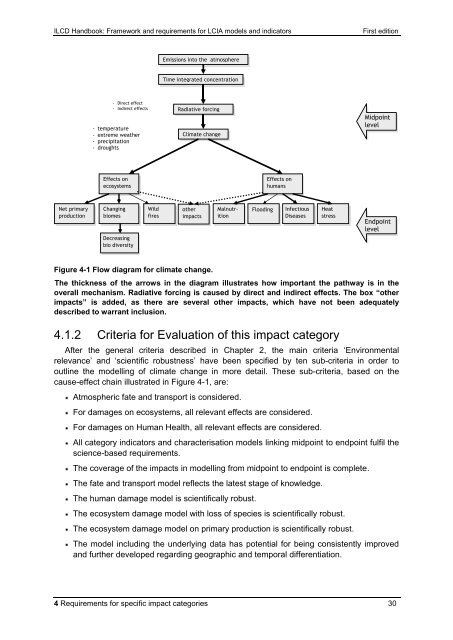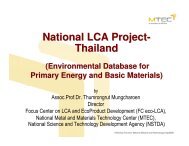ILCD Handbook: Framework and requirements for LCIA models and ...
ILCD Handbook: Framework and requirements for LCIA models and ...
ILCD Handbook: Framework and requirements for LCIA models and ...
You also want an ePaper? Increase the reach of your titles
YUMPU automatically turns print PDFs into web optimized ePapers that Google loves.
<strong>ILCD</strong> <strong>H<strong>and</strong>book</strong>: <strong>Framework</strong> <strong>and</strong> <strong>requirements</strong> <strong>for</strong> <strong>LCIA</strong> <strong>models</strong> <strong>and</strong> indicators First edition<br />
Net primary<br />
production<br />
- Direct effect<br />
- Indirect effects<br />
- temperature<br />
- extreme weather<br />
- precipitation<br />
- droughts<br />
Effects on<br />
ecosystems<br />
Changing<br />
biomes<br />
Decreasing<br />
bio diversity<br />
Wild<br />
fires<br />
Emissions into the atmosphere<br />
Time integrated concentration<br />
Radiative <strong>for</strong>cing<br />
Climate change<br />
other<br />
impacts<br />
Figure 4-1 Flow diagram <strong>for</strong> climate change.<br />
Malnutrition<br />
Flooding<br />
Effects on<br />
humans<br />
Infectious<br />
Diseases<br />
4 Requirements <strong>for</strong> specific impact categories 30<br />
Heat<br />
stress<br />
Midpoint<br />
level<br />
Endpoint<br />
level<br />
The thickness of the arrows in the diagram illustrates how important the pathway is in the<br />
overall mechanism. Radiative <strong>for</strong>cing is caused by direct <strong>and</strong> indirect effects. The box “other<br />
impacts” is added, as there are several other impacts, which have not been adequately<br />
described to warrant inclusion.<br />
4.1.2 Criteria <strong>for</strong> Evaluation of this impact category<br />
After the general criteria described in Chapter 2, the main criteria ‗Environmental<br />
relevance‘ <strong>and</strong> ‗scientific robustness‘ have been specified by ten sub-criteria in order to<br />
outline the modelling of climate change in more detail. These sub-criteria, based on the<br />
cause-effect chain illustrated in Figure 4-1, are:<br />
Atmospheric fate <strong>and</strong> transport is considered.<br />
For damages on ecosystems, all relevant effects are considered.<br />
For damages on Human Health, all relevant effects are considered.<br />
All category indicators <strong>and</strong> characterisation <strong>models</strong> linking midpoint to endpoint fulfil the<br />
science-based <strong>requirements</strong>.<br />
The coverage of the impacts in modelling from midpoint to endpoint is complete.<br />
The fate <strong>and</strong> transport model reflects the latest stage of knowledge.<br />
The human damage model is scientifically robust.<br />
The ecosystem damage model with loss of species is scientifically robust.<br />
The ecosystem damage model on primary production is scientifically robust.<br />
The model including the underlying data has potential <strong>for</strong> being consistently improved<br />
<strong>and</strong> further developed regarding geographic <strong>and</strong> temporal differentiation.



